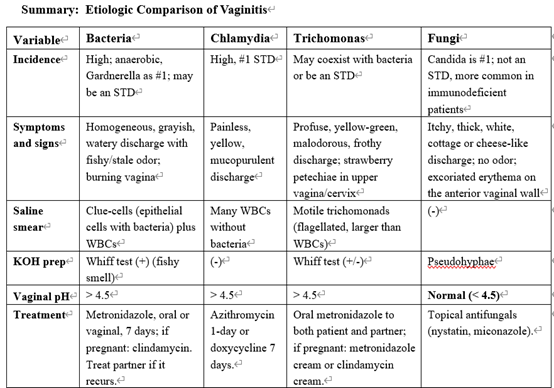Clinical Pearl Series Edited from Yale-G First Aid: Crush USMLE Step 2CK & Step 3 by Yale Gong, MD, Sr. Medical Advisor at www.medicine.net (Copyrighted)
Vaginitis
Vaginitis is an inflammation of the vagina and mostly a sexually transmitted disease (STD). Normally the vagina contains mixed bacterial flora in a protective acidic environment (pH 3.5-4.5), which is maintained by lactobacilli. Any factors that increase the vaginal pH value (such as frequent unsanitary sexual intercourses, drugs, diseases) can cause overgrowth of other bacterial species and infection. Common pathogens include chlamydia, bacteria, fungi, and protozoan, and should be treated accordingly. Remember that the urinary tract is (required) sterile but the vagina is not.

Cervicitis
It’s an inflammation of the uterine cervix, usually coexisting with vulvovaginitis. The prevalence is at least 80% among sexually active females.
Etiology
1. Infection: Common pathogens are Chlamydia, Gonococcus, Trichomonas, herpes simplex virus (HSV), and human papillomavirus (HPV).
2. Others: Trauma, malignancy, radiation, etc.
Essentials of diagnosis
1. Most patients are asymptomatic. Yellow-green mucopurulent discharge from the cervix indicates bacterial or trichomonas infection. Erosive cervicitis is a common chronic type and a localized feature of the chronic uterine inflammatory process. The main symptoms include increased leukorrhea, itching and pain in the vulva, pain in the lower abdomen and lumbosacral region, and frequent or difficult urination. It’s also a risk factor for cervical cancer.
2. A pelvic examination usually reveals redness of the cervix, evidence of discharge, and cervical motion tenderness.
3. Lab tests: Discharge inspection under a microscope may prove candidiasis, bacteria, or trichomoniasis. Special tests may be performed for suspected Chlamydia or Gonococcus. Pap smear for cytology may be required for patients with cancer risks.
Treatment
Based on etiology —similar antibiotics for vaginitis and pelvic inflammatory disease (PID) are used to cover Gonococcus, Chlamydia, and the anaerobes.







Post comments